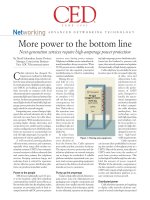Tài liệu Indoor Air Pollution: The Quiet Killer pptx
Bạn đang xem bản rút gọn của tài liệu. Xem và tải ngay bản đầy đủ của tài liệu tại đây (295.44 KB, 8 trang )
Indoor Air Pollution:
The Quiet Killer
VINOD MISHRA
ROBERT D. RETHERFORD
KIRK R. SMITH
Analysis from the East-West Center
No. 63
October 2002
SUMMARY Air pollution in big cities gets headlines, but in many rural
areas of developing countries indoor air pollution is an even more serious
health problem. Long-term exposure to smoke from cooking indoors with
wood, animal dung, and other biomass fuels contributes to respiratory ill-
ness, lung cancer, and blindness. As a cause of ill health in the world, indoor
air pollution ranks behind only malnutrition, AIDS, tobacco, and poor
water/sanitation. The results of a national household survey in India linking
cooking smoke to tuberculosis and blindness in adults and acute respiratory
infections in children add to a growing body of evidence from other studies
that reducing exposures to toxic emissions from cookstoves can substantially
improve health and save lives. Governments can do more to promote clean
fuel use, educate people to the risks of exposure to cook smoke, and provide
and promote more efficient and better-ventilated cookstoves. Curbing indoor
air pollution is not only a key to better health but also an important invest-
ment for achieving development goals and improving living standards.
The U.S. Congress established
the East-West Center in 1960 to
foster mutual understanding and
cooperation among the govern-
ments and peoples of the Asia
Pacific region, including the United
States. Funding for the Center
comes from the U.S. government
with additional support provided
by private agencies, individuals,
corporations, and Asian and Pacific
governments.
The AsiaPacific Issues series
contributes to the Center’s role as
a neutral forum for discussion of
issues of regional concern. The
views expressed are those of the
author and not necessarily those
of the Center.
AsiaPacific
ISSUES
Around the world, urban air pollution attracts wide-
spread public attention and produces calls for action.
Air pollution is all too visible to city residents, and it
poses risks to the health of all who breathe polluted
air. Yet in rural areas of developing countries, indoor
air pollution can be much worse than atmospheric
pollution levels in big cities.
Indoor air pollution is a major public health prob-
lem in developing countries, where it accounts for much
ill health and well over a million deaths annually.
Estimates are that several hundred thousand women
and children in India alone die prematurely because
of indoor air pollution.
i
Data to be released shortly
by the World Health Organization (WHO) indicate
that, worldwide, indoor air pollution (mostly in de-
veloping countries) ranks fifth—behind malnutrition,
AIDS, tobacco, and poor water/sanitation—on the
percentage of ill health accounted for by various risk
factors.
ii
Despite its large effect, it is a quiet killer, hid-
den from public view, affecting mostly the poor and,
among them, women and young children especially.
Why is the problem of indoor air pollution so
widespread? Nearly half of the world’s households
use unprocessed biomass fuels—wood, animal dung,
crop residues, and grasses—for cooking and heating.
In the developing countries of South Asia and sub-
Saharan Africa, as many as 80 percent of all homes
cook with biomass fuels. The proportions relying on
biomass fuels are even higher in the rural areas of
these countries.
Biomass fuels are an inefficient source of energy.
Because combustion is incomplete, burning them
in open fireplaces or in simple indoor cookstoves re-
leases large amounts of health-damaging air pollu-
tants. The problem is aggravated, as is often the case
in poor rural households, when cooking areas are in-
adequately ventilated and the dwelling lacks a separate
kitchen. Even when biomass cookstoves are vented
to the outdoors, they can produce enough noxious
emissions to raise pollution levels in the surround-
ing neighborhood to unhealthy levels.
In homes with poorly ventilated cooking areas,
residents—particularly women and the young chil-
dren under their care—are regularly exposed to nox-
ious pollutants such as respirable particulate matter
(i.e., fine particles that can reach deep into the lungs),
carbon monoxide, nitrogen oxides, formaldehyde, and
dozens of toxic polyaromatic hydrocarbons (such as
benzo[a]pyrene). Moreover, fires from biomass fuels
require more or less continual feeding, resulting in ex-
tended exposure to their smoke. Many people are ex-
posed for three to seven hours daily, and even longer
in winter months when houses must also be heated.
Because biomass cookstoves are usually used for sev-
eral hours each day at times when people are present
indoors, indoor exposures to airborne pollutants tend
to be much greater than outdoor exposures. In such
settings, daily average and peak exposures to air pol-
lutants often far exceed safe levels recommended by
the World Health Organization. Typical levels of
carbon monoxide and respirable particulate matter
in developing-country homes that use biomass fuels
usually exceed U.S. Environmental Protection Agency
guidelines by several times.
iii
There is a growing body of evidence that long-
term exposure to high levels of smoke from burning
biomass fuels is linked to a number of specific dis-
eases that are widespread in many developing coun-
tries. Exposure to biomass cooking smoke has been
linked to a host of respiratory diseases, including
acute respiratory infections (ARI), chronic bronchi-
tis, asthma, and tuberculosis. It has also been linked
to lung cancer, adverse pregnancy outcomes, cataract,
and blindness.
How Does Cooking Smoke Cause Ill Health?
The mechanisms by which cooking smoke causes ill
health are only partially understood. Studies have
shown that exposure to biomass smoke is associated
with compromised pulmonary immune defense mech-
anisms in both animals and humans. Of the specific
pollutants in biomass smoke, exposure to respirable
particulate matter has been shown to induce a sys-
temic inflammatory response involving stimulation
of the bone marrow, which can contribute to cardio-
respiratory morbidity. Other evidence indicates that
exposure to polycyclic aromatic hydrocarbons—
especially benzo[a]pyrene, which is found in large
quantities in biomass smoke—can cause immune
Analysis from the East-West Center
2
Indoor air pollution
affects mostly the
poor and, among
them, mostly wom-
en and children
suppression and can increase the risk of infection and
disease. Benzo[a]pyrene, a known carcinogen, also
can increase the risk of lung and other types of cancers.
Acute exposures to oxides of nitrogen, commonly
found in biomass smoke, have been associated with
increased bronchial reactivity and susceptibility to
bacterial and viral infections. Carbon monoxide in
biomass smoke combines with hemoglobin to form
carboxyhemoglobin, which reduces the oxygen-
carrying capacity of the blood and can contribute to
anemia and adverse pregnancy outcomes, including
miscarriage, stillbirth, low birth weight, and early in-
fant mortality. Extended exposure to biomass smoke
has also been shown to cause oxidative damage to the
eye lens and can cause cataract.
The quantity and quality of scientific literature on
the health effects of cooking smoke vary considerably
by type of disease. Many studies have examined the
effects of cooking smoke on ARI in children.
iv
Several
of them show that young children living in homes
that burn biomass fuels have two to three times the
risk of developing serious respiratory infections than
children who are not exposed. A number of studies
have shown that women in developing countries who
cook with biomass fuels have two to four times the
risk of chronic obstructive pulmonary disease (e.g.,
chronic bronchitis) than women who cook with cleaner
fuels. Several studies, but not all, have shown a posi-
tive association between cooking smoke and asthma.
v
On the other hand, only a handful of studies have
examined the effects of cooking smoke on tubercu-
losis, lung cancer, pregnancy outcomes, eye ailments,
heart disease, and other health outcomes.
This issues paper reports on findings from three
studies that link exposure to cooking smoke to tuber-
culosis, acute respiratory infections, and blindness,
based on data from a national household survey in
India. All results reported here were controlled for
demographic and socioeconomic factors (see box).
vi–viii
Fueling the Spread of Tuberculosis
Tuberculosis, which kills about 2 million people each
year worldwide, is resurgent. “Tuberculosis, which
many of us believed would disappear in our lifetime,
has staged a frightening comeback,” says Gro Harlem
Brundtland, Director-General of the World Health
Organization.
TB is an airborne contagious disease that is trans-
mitted by coughing, sneezing, or even talking. Once
a person becomes infected, any condition that weak-
ens the immune system can trigger the development
of active TB. Typically about 5–10 percent of infected
persons eventually develop active TB. In many coun-
tries TB is on the rise as HIV/AIDS spreads, as drug-
resistant strains of the disease become more common,
and as health systems fail to respond adequately.
Exposure to cooking smoke can increase the risk
of TB by reducing resistance to initial infection or by
promoting the development of active TB in already-
infected persons. As indicated earlier, extended ex-
posure to the pollutants contained in biomass smoke
can weaken the immune system, impair the lungs,
and make them more susceptible to infection and
disease. Cooking smoke also tends to increase cough-
ing, which contributes to the spread of TB infection.
Tuberculosis is common in India, where about half
of the adult population are infected with TB bacte-
ria, millions have active disease, and about half a mil-
lion die from it every year. Data from India’s National
Family Health Survey show that people living in
households that cook with wood and dung are 2.6
times more likely to suffer from active TB than adults
in households using cleaner fuels (Figure 1).
vi
As might be expected—because women do most
of the cooking and are more exposed to indoor air
Analysis from the East-West Center
3
People living in
households that
cook with wood and
dung are 2.6 times
more likely to suf-
fer from active TB
Fig. 1. Prevalence of active tuberculosis by
type of cooking fuel among persons age 20
years and older, India
pollution than are men—women are more affected
than men. Figure 1 shows that, with other factors
controlled, active TB is 2.7 times more common
among women and 2.4 times more common among
men in households that cook with wood and dung
than in households that do not. Among both men
and women, the effect of exposure to cooking smoke
is also greater in rural areas than in urban areas, per-
haps mainly because medical services to treat TB are
less widely available in rural than in urban areas.
The analysis estimated that about half of active TB
among Indian adults is attributable to exposure to
biomass cooking smoke. This statistic reflects not only
the large effect of biomass smoke on the risk of TB
but also the widespread use of biomass fuels for cook-
ing. In rural areas nearly three-fifths of active TB is
attributable to biomass cooking smoke, and in urban
areas nearly one-quarter, reflecting both a bigger effect
of biomass smoke and wider use of biomass fuels in
rural areas than in urban areas.
A study in Mexico has confirmed the strong link
between biomass smoke and TB found in India (see
box). The similar findings from the India and Mexico
studies, which were based on quite different research
designs, are persuasive and have important public
health implications worldwide.
Exacerbating Acute Respiratory Infections
in Children
ARI is a disease category that includes severe respi-
ratory infections from a range of viruses and bacte-
ria with similar symptoms and risk factors. ARI is a
leading cause of childhood illness and death world-
wide, accounting for an estimated 6.5 percent of the
global burden of disease. More than three million
Analysis from the East-West Center
4
About half of active
TB among Indian
adults is attribut-
able to exposure to
biomass cooking
smoke
India’s National Family Health Survey
India’s 1992–93 National Family Health Survey collected
socioeconomic, demographic, and health information
from a nationally representative survey of about 89,000
households. East-West Center researchers played a
major role in the design, implementation, and analysis of
the survey, which asked a number of questions about
the current health status of household members—
including questions about tuberculosis, acute respira-
tory infections, and partial and complete blindness.
In the case of tuberculosis, the household head or
other knowledgeable adult in the household reported
whether each household member suffered from active
tuberculosis. In the case of blindness, the household
respondent reported whether each household mem-
ber suffered from partial or complete blindness. In the
case of ARI, the mothers of young children were asked
whether the child had been ill with a cough during the
two weeks before the survey and, if so, whether the child
breathed faster than usual with short, rapid breaths.
The survey did not test clinically for active tuberculo-
sis, blindness, or ARI.
The survey also asked about the primary cooking
fuel used in the household. In the analysis, fuel type
serves as an indirect measure of exposure to cooking
smoke. (Indoor air pollution measurements in develop-
ing countries have shown fuel type to be the best sin-
gle indirect indicator of household pollution levels.) The
survey asked about the following fuel types: wood,
dung cakes, coal/coke/lignite, charcoal, kerosene, elec-
tricity, liquefied petroleum gas (LPG), biogas, and a
residual category of other fuels.
Information on fuel types was used to group house-
holds into categories representing extent of exposure
to cooking smoke—high pollution fuels (wood, dung
cakes), medium pollution fuels (coal/coke/lignite,
charcoal, kerosene), and low pollution fuels (LPG, bio-
gas, electricity). Because the differences in disease
prevalence between the medium- and low-pollution fuel
categories were generally small, only two categories
(biomass fuels, cleaner fuels) were ultimately used in
the analysis.
The analysis of the effect of fuel type on TB, ARI,
and blindness controlled for several demographic and
socioeconomic factors that affect both exposure to
cooking smoke and disease prevalence. These factors
are age, sex, urban/rural residence, education, reli-
gion, caste/tribe, availability of a separate kitchen,
housing type (based on the quality of construction of
roof, walls, and floor), indoor crowding, and geo-
graphic region. The analysis did not control for expo-
sure to tobacco smoke because the survey did not ask
about smoking. For the same reason, the analysis did
not take into account the household’s history of fuel
use, fuel mix, or utilization of medical services. To
some extent, however, the socioeconomic variables
control indirectly for utilization of medical services.
children under age five die from ARI every year, mostly
in developing countries. In India, as in many other
developing countries, pneumonia and other acute
respiratory infections cause much illness, suffering,
and death among young children.
Analysis of the India survey shows that, with other
variables controlled, children under age three living
in households that cook using biomass fuels are 32
percent more likely to have suffered from ARI than
children in households that cook using cleaner fuels
(Figure 2).
vii
The prevalence of ARI is considerably lower among
girls than among boys, and the effect of cooking
smoke on ARI is smaller for girls than for boys. The
prevalence of ARI is 40 percent higher for boys and
22 percent higher for girls in households using bio-
mass fuels than in households using cleaner fuels. A
lower prevalence of ARI among girls could occur if
there is more underreporting of ARI for girls than for
boys. Similarly, a lower effect of cooking smoke on
ARI for girls, relative to boys, could occur if under-
reporting of ARI for girls is greater in households
that use biomass fuels than in households that use
cleaner fuels. The sex differentials could also occur if,
as is common in India, mothers are more likely to
carry young boys or keep them in the kitchen area
while cooking than young girls, thereby inadvertently
exposing boys to higher levels of air pollution. In this
case, ironically, discrimination against girls may work
to their advantage.
The analysis estimated that about 20 percent of
acute respiratory infections among children under
age three are attributable to cooking smoke. As with
TB, this statistic reflects not only the effect of bio-
mass smoke on ARI but also the widespread use of
biomass fuels for cooking in India.
Contributing to Partial and Complete
Blindness
Blindness is another important public health problem
in many developing countries. In India, an estimated
30 million people suffer from partial or complete
blindness—tragically high numbers for a usually pre-
ventable condition. According to India’s National
Family Health Survey, 8 percent of women age 30
and older suffer from partial or complete blindness,
the prevalence of which increases rapidly with age.
Most blindness is partial—that is, seriously impaired
Analysis from the East-West Center
5
About 20% of
acute respiratory
infections among
children under age
three are attribut-
able to cooking
smoke
Mexican Study Confirms Link Between
Cooking Smoke and TB
ix
In Mexico, wood is the primary cooking fuel used in
about half of all households and nearly 70 percent of
rural households. In order to test the India finding of
a large effect of cooking smoke on TB, researchers
at the National Institute of Respiratory Diseases in
Mexico City conducted a hospital-based case-con-
trol study in 1998–99.
The study compared nearly 300 patients with clin-
ically confirmed cases of TB, by extent of exposure
to cooking smoke from traditional wood stoves. The
study compared the patients with confirmed TB with
an otherwise similar control group of over 500
patients who had ear, nose, or throat ailments but did
not have TB.
After controlling for the socioeconomic status of
participating patients, the study estimated an effect
of cooking smoke on TB similar in magnitude to that
reported in the India study. With socioeconomic sta-
tus controlled, patients from households with wood-
burning stoves were found to be 2.4 times as likely to
have active TB as patients from non-wood-burning
households—compared with 2.6 times in the India
study. In the Mexico study, the link between wood
smoke exposure and TB was additionally found to be
independent of exposure to cigarette smoke.
Fig. 2. Prevalence of acute respiratory infec-
tions by type of cooking fuel among children
under 3 years of age, India
vision due to blindness in one eye, partial cataract,
night blindness, or any other eye ailment.
Long-term exposure to cooking smoke probably
contributes to impaired vision and blindness mainly
through oxidative damage to the eye lens and severe
eye irritation, leading to cataract and other disorders.
In India, cataract accounts for more than 80 percent
of complete blindness. Another direct cause of blind-
ness, conjunctivitis, may also be aggravated by long-
term exposure to cooking smoke. Trachoma, which
also can cause blindness, can be contracted when irri-
tation from exposure to cooking smoke causes people
to rub their eyes frequently.
Anecdotal association between eye problems and
cooking smoke is common, but epidemiological
studies of this association are few. There exist a few
laboratory studies that have linked cataract to both
wood smoke and tobacco smoke. A case-control study
of 1,990 patients at a New Delhi ophthalmic clinic
showed that, after controlling for other variables,
use of wood and dung for cooking was significantly
associated with cataract.
x
The analysis of the India survey estimated that
women in households using biomass fuels are 27 per-
cent more likely to suffer from partial blindness and
35 percent more likely to suffer from complete blind-
ness than women in households using cleaner fuels
(Figure 3). The study estimated that 17 percent of
partial blindness and 20 percent of complete blind-
ness among Indian women aged 30 and older are
attributable to cooking smoke.
viii
What Can Be Done?
Recognizing the adverse health consequences of in-
door air pollution is easier than addressing the prob-
lem effectively. Widespread adoption of cleaner fuels
probably would do most to reduce indoor air pollu-
tion, but poor households that currently rely on bio-
mass fuels are unlikely to be able to afford cleaner
fuels any time soon. And because few poor people
can afford to use cleaner fuels, markets have yet to
develop to supply them, so many rural communities
lack access to improved cookstoves and cleaner sources
of energy.
In the long run, rising levels of development will
reduce indoor air pollution from cooking smoke as
households gradually shift to cleaner fuels. The inter-
national health community and government public
health officials have an obligation, however, not to
wait for the long run. The scientific evidence pre-
sented here and elsewhere clearly indicates that health
hazards from indoor air pollution are a major public
health problem that needs immediate attention. “The
art and science of public health is in finding ways to
make people healthy before they become wealthy.”
xi
Millions of people could be healthier if they had
less exposure to biomass cooking smoke. Actions to
reduce exposure include:
• Promoting use of cleaner fuels
• Educating people about the risks of
exposure to cooking smoke
• Providing more efficient and better-
ventilated cookstoves
Inexpensive but highly efficient cookstoves that
use biomass fuels are an important part of an effec-
tive short-run strategy. There is ample evidence that
even poor people are willing to pay (or at least help
pay) for better stoves that improve their health. The
most successful cookstove program has been in China,
where some 200 million improved stoves have been
Analysis from the East-West Center
6
Fig. 3. Prevalence of partial and complete
blindness by type of cooking fuel among
women age 30 years and older, India
In China, 200 mil-
lion improved cook-
stoves have been
introduced, proof
that concerted ac-
tion can achieve
remarkable results
introduced in recent decades. The Chinese program
demonstrates that a concerted action program can
achieve remarkable results.
It is unlikely, however, that any single “magic
stove” technology could solve the indoor air pollu-
tion problems in developing countries. Cookstove
technologies must not only be acceptable technically
and economically, but also accommodate people’s
social and cultural preferences regarding food avail-
ability and preparation.
While a number of programs have promoted bet-
ter cookstoves, the effectiveness of these programs in
reducing indoor air pollution is not well documented.
Although several hundred programs in China, India,
and elsewhere have promoted improved cookstoves,
no independent systematic evaluation of their effec-
tiveness has been conducted. Despite the lack of ade-
quate evaluation research, there exists evidence that
indoor pollution levels from biomass cookstoves cur-
rently in use remain extremely high, as indicated by
a recent review published in the Bulletin of the World
Health Organization.
iii
Although thousands of large and rigorous studies
have measured how cigarette smoking affects health
worldwide, only a few dozen studies have measured
how cooking smoke affects health. Moreover, hardly
any research has been done on the distribution and
magnitude of exposure to cooking smoke in develop-
ing countries, and in spite of widespread use of bio-
mass fuels and rising concerns about air pollution and
deforestation, surprisingly few studies have attempted
to assess the feasibility and cost-effectiveness of sub-
stituting biomass fuels with cleaner fuels.
Because indoor air pollution from cooking and
heating is often worst in poor, remote, rural areas, it
tends to receive less attention than more visible ambi-
ent air pollution in cities and other proximate health
problems that catch public attention. Moreover, only
a small fraction of biomass fuels are purchased through
formal markets. Instead, people—mainly women
and girls—gather fuelwood and other biomass in
the countryside. Their energy-supply efforts do not
show up on accounting ledgers or as commercial
transactions. Thus use of biomass fuels is not ade-
quately measured in national and international data
collection efforts. For example, the International
Energy Agency started listing biomass fuels in its an-
nual compendia only in the late 1990s, and only at a
high level of aggregation, lacking more detailed data.
Substitution of other fuels for biomass fuels is not
without its own problems. Some governments have
focused on biomass fuel use primarily in terms of its
effect on depletion of forest resources, and in some
countries proposals have been made to reduce pres-
sures on forests by substituting coal for wood as fuel
for use in homes. While such proposals could have
potential environmental benefits, they also entail
potential health hazards. Recent studies in China and
South Africa, as well as earlier studies in the United
Kingdom, have shown that indoor use of coal can
lead to substantial health problems. One reason why
China has one of the highest rates of lung cancer in
the world for non-smoking women is the extensive
use of coal for cooking and heating within homes.
In the short run, a major shift to cleaner and more
energy-efficient cookstoves in poor, rural households
in developing countries could substantially reduce
the burden of ill health. Additionally, there is need
for public information campaigns designed to inform
people about the health risks of exposure to cooking
smoke. For such programs to be effective, local needs
and community participation should receive high
priority. Programs that promote improved cookstoves
and educate the public about adverse health effects
of cooking smoke are an excellent government in-
vestment that can contribute not only to improved
health but also to increased productivity and devel-
opment goals.
Analysis from the East-West Center
7
Local needs and
community parti-
cipation must re-
ceive high priority
Analysis from the East-West Center
8
About this Publication
The AsiaPacific Issues series reports on
topics of regional concern.
Series Editor: Elisa W. Johnston
The contents of this paper may be repro-
duced for personal use. Single copies may
be downloaded from the Center’s website.
Copies are also available for $2.50 plus
shipping. For information or to order copies,
please contact:
Publication Sales Office
East-West Center
1601 East-West Road
Honolulu, Hawaii 96848-1601
Telephone: (808) 944-7145
Facsimile: (808) 944-7376
Email:
Website: www.EastWestCenter.org
ISSN: 1522-0966
© 2002 East-West Center
Recent AsiaPacific Issues
No. 62 “The Case for U.S. Leadership in
Rebuilding Afghanistan” by Wali M. Osman.
September 2002.
No. 61 “Seeking Justice on the Cheap: Is
the East Timor Tribunal Really a Model for
the Future?” by David Cohen. August 2002.
No. 60 “Managing Asia Pacific’s Energy
Dependence on the Middle East: Is There
a Role for Central Asia?” by Kang Wu and
Fereidun Fesharaki. June 2002.
No. 59 “China’s State-Owned Enterprises:
Thriving or Crumbling?” by Christopher A.
McNally. March 2002.
No. 58 “As Asia’s Population Ages, Worries
Grow About the Future” by Andrew Mason,
Sang-Hyop Lee, and Gerard Russo. January
2002.
No. 57 “Putting the Pieces in Place for
Japan’s Economic Recovery” by Terutomo
Ozawa. December 2001.
No. 56 “‘Déjà vu all over again?’ Why Dia-
logue Won’t Solve the Kashmir Dispute” by
Arun R. Swamy. November 2001.
About the Authors
Vinod Mishra is a fellow at the East-West
Center in the Research Program.
He can be reached at:
Telephone: (808) 944-7452
Email:
Robert D. Retherford is a senior fellow at
the East-West Center and coordinator of
Population and Health in the Research
Program.
He can be reached at:
Telephone: (808) 944-7403
Email:
Kirk R. Smith is a senior fellow at the
East-West Center and professor and chair
of Environmental Health Sciences at the
University of California, Berkeley.
He can be reached at:
Telephone: (510) 643-0793
Email:
Notes
i
Smith, K.R. 2000. National burden of disease in India from in-
door air pollution. Proceedings of the National Academy of Sciences
97(24): 13286–93.
ii
World Health Organization. 2002. World Health Report 2002.
Geneva: World Health Organization.
iii
Bruce, N., R. Perez-Padilla, and R. Albalak. 2000. Indoor air
pollution in developing countries: a major environmental and
public health challenge. Bulletin of the World Health Organization
78(9).
iv
Smith, K.R., J.M. Samet, I. Romieu, and N. Bruce. 2000. In-
door air pollution in developing countries and acute respiratory
infections in children. Thorax 55: 518–532.
v
Mishra, V. In press. Indoor air pollution from biomass com-
bustion and asthma in elderly. Environmental Health Perspectives.
vi
Mishra, V.K., R.D. Retherford, and K.R. Smith. 1999. Bio-
mass cooking fuels and prevalence of tuberculosis in India. Inter-
national Journal of Infectious Diseases 3(2): 119–129.
vii
Mishra, V. In press. Gender aspects of indoor air pollution and
health: an analysis of gender differentials in the effect of cooking
smoke on acute respiratory infections in children. In Gender Ana-
lysis in Health, Claudia Garcia-Moreno and Rachel Snow (eds.).
Geneva: World Health Organization.
viii
Mishra, V.K., R.D. Retherford, K.R. Smith. 1999. Biomass
cooking fuels and prevalence of blindness in India. Journal of
Environmental Medicine 1(4): 189–199.
ix
Perez-Padilla, R., C. Perez-Buzman, R. Baez-Saldana, A. Torres-
Crus. Cooking with biomass stoves and tuberculosis: a case con-
trol study. International Journal of Tuberculosis and Lung Disease
5(5): 1–7.
x
Mohan, M.R., D. Sperduto, S.K. Angra, et al. 1989. India-US
case-control study of age-related cataracts. Archives of Ophthal-
mology 107: 670–676.
xi
Smith, K.R. 2002. Indoor air pollution in developing countries:
recommendations for research. Indoor Air 12: 1–7.
See also National Family Health Survey Bulletins at
/>









